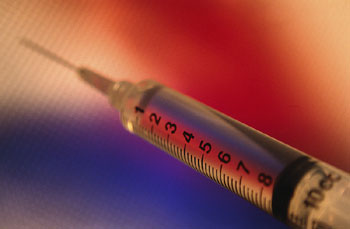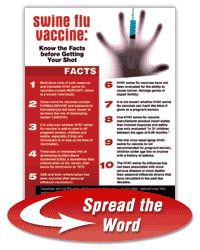 By Dr. Mercola
By Dr. MercolaI've said it before, but I'll say it again: I'm not anti-vaccines, but rather pro vaccine-safety. That means, I strongly believe that we should only inject substances into our bodies, and especially into the bodies of infants and the unborn, that have been rigorously studied and proven safe both short-term and long-term.
As it stands now, we've spent decades injecting materials into the bodies of young and old alike, without sufficient amounts of safety testing of the ingredients, and our society is showing the signs of this neglect.
Neurological dysfunction and disorders such as autism and Alzheimer's have been growing steadily and show no signs of slowing down.
Mercury, in the form of thimerosal, is included in the majority of all flu vaccines as a preservative in multi-dose vials. Thimerosal-free single-dose vials are typically reserved for infants under the age of three, and pregnant women only.
I recently published a long list of studies confirming the health dangers of thimerosal -- proof that those who claim "thimerosal has never been shown to cause any damage" are not telling you the truth. There's plenty of evidence to the contrary, and if you missed that article, I recommend you review it now.
But thimerosal is not the only questionable and potentially dangerous ingredient in flu vaccines.
Adjuvants Explained
In order for a vaccine to be considered effective, your immune response to the vaccine should be to produce antibodies to the live or dead viruses in the vaccine (the antigen). An adjuvant is a substance added to a vaccine to improve your immune response to the antigen. The word comes from the Latin adjuvare, which means "to help."
By adding adjuvants the vaccine can contain less viral antigens, which reduces production costs.
Unfortunately, many of these adjuvants are highly toxic.
There are several types of adjuvants. Some of the most commonly used ones include:
- Aluminium hydroxide
- Aluminium phosphate
- Calcium phosphate
Other adjuvants include oil-based emulsions such as squalene, Squalene has not been licensed by the FDA for use in vaccines distributed in the U.S. yet, although squalene is an adjuvant used in vaccines distributed in Europe and other countries.
GlaxoSmithKline's proprietary formula ASO3™ and Novartis' MF59™ are two examples of squalene adjuvants.
As damaging as the neurotoxin mercury is, it's important to realize that aluminum is also a neurotoxin and aluminum-based adjuvants are estimated to be even MORE toxic than mercury.
GREAT NEWS -- No Squalene Allowed in US Swine Flu Vaccines!
Fortunately, Americans can draw a sigh of relief as it pertains to squalene -- one of the most controversial of the adjuvants -- at least for now.
Although vaccine manufacturers were pushing to be allowed to use squalene in many of the swine flu vaccines, and the US Department of Health and Human Services purchased spent more than $400 million of tax payers' money to stockpile the oil-based adjuvant, their efforts have been unsuccessful so far.
In order to legally allow unlicensed squalene adjuvants to be included in licensed H1N1 vaccines, the US government would have had to issue an Emergency Use Authorization (EUA).
There have been small H1N1clinical trials in which experimental squalene adjuvants were included and tested, which have been reported by various media sources, fueling the questions about its use. But that is different from an FDA licensed vaccine that is made available for general public use.
To date, no EUA has been issued, so the swine flu vaccines licensed for use in the US do NOT contain squalene. However, it is still unclear whether the National Emergency declaration issued by President Obama on October 23, 2009, will cover adding novel adjuvants like squalene, or whether a separate EUA must be issued to allow the use of unlicensed adjuvants.
The best way to confirm the existence of vaccine components is to consult the vaccine product manufacturer inserts. Below, you will find links to the inserts for the four H1N1 vaccines licensed for use in the US.
You may also want to review the transcript of the July 23, 2009 meeting of the FDA Vaccines & Related Biological Products Advisory Committee for more information on the discussion about whether the FDA should issue an EUA and allow unlicensed adjuvants in US vaccines.
Thankfully, so far, the FDA has declined to approve squalene adjuvants for US H1N1 vaccines, but that does not mean that the drug companies will not continue to press for approval in the future.
Beware: European Vaccines May Contain Squalene
Unfortunately, vaccine manufacturers have persuaded countries in Europe and elsewhere to add squalene to seasonal influenza and H1N1 vaccines, so if you live outside the US, you will need to do some further research to determine which vaccines may contain squalene.
A recent article in the English version of the German news source The Local, for example, warns that the German Defense Ministry has ordered a special stock of H1N1 vaccines for their troops that will contain neither mercury nor adjuvants, whereas the general public will be given vaccines containing both.
When checking for squalene, beware that the ingredient called MF59™ is an oil-in-water emulsion of squalene, Tween™80 (polyoxyethylene sorbitan monooleate), and sorbitan trioleate.
MF59 is approved for human use in Europe, but not in the U.S.
Four Swine Flu Vaccines have Gained US FDA Approval
Below I will review the list of ingredients for the four swine flu vaccines that gained U.S. FDA approval on September 15. (As of this writing, GlaxoSmithKline is the only contracted vaccine manufacturer that has not yet gotten their swine flu vaccine approved.)
Please note that there may be additional anti-virals available that are being used to treat swine flu, and/or swine flu vaccines on the market in other countries, but this article only covers the following four vaccines that have received FDA approval for use in the US:
- MedImmune (intranasal spray)
- Novartis
- Sanofi-Pasteur
- CSL
These companies, along with GlaxoSmithKline, have all been awarded contracts by the U.S. Department of Health and Human Services (HHS) for development and production of more than 195 million doses of swine flu vaccine.
For more information, warnings and side effects of each ingredient, please follow the hyperlinks provided.
MedImmune
MedImmune, which is a subsidiary of London-based AstraZeneca, offers an intranasal spray that contains live attenuated virus. The package insert for MedImmune's intranasal vaccine can be found here.
Please note that the adverse reaction information for MedImmune's vaccine is based on studies conducted with the seasonal flu version known as FluMist.
Please review the insert for numerous warnings, contraindications, and adverse reactions.
Of special note are the warnings that it should not be administrated to children and adolescents (2-17 years of age) receiving aspirin therapy or aspirin-containing therapy, because of association of Reye's syndrome.
In addition, it's important to realize that safety has not been established in individuals with underlying medical conditions predisposing them to influenza complications.
MedImmune's vaccine also should not be administered to any individual with asthma, or children under the age of 5 with recurring wheezing because of the potential for increased risk of wheezing post vaccination.
Lastly, please note that some viruses contained in this and other intranasal vaccines CAN spread from the vaccinated person to others. Hence, if a person has a compromised immune system, he or she could be placed at risk of infection from people who have been vaccinated. The ease of transmission appears to vary from strain to strain.Dosing Instructions for MedImmune Intranasal Spray vaccine:
- Children 0-2 years: Not approved
- Children 2-9 years: 2 doses, 0.2 ml each, approximately one month apart
- Children and adults between the ages of 10-49 years: 1 dose, 0.2 ml
- Adults 50-65: Not approved, as FluMist was found to have no demonstrable effectiveness in this age group
- Seniors 65 and over: Not approved
- Pregnant women: Not recommended
Ingredients include:
- Live, attenuated virus
- Monosodium glutamate. MSG is a known neurotoxin and excitotoxin.
- Egg proteins
- Sucrose (table sugar)
- Dibasic potassium phosphate
- Monobasic potassium phosphate
- Gentamicin sulfate (antibiotic)
Intranasal vaccines do not contain thimerosal (mercury).
Questionable Efficacy…
According to the insert, FluMist has demonstrated a mere 44.5 percent reduction in influenza rate when looking at all strains, compared to active controls (other flu vaccines).
Novartis
The package insert for Novartis' Influenza A(H1N1) 2009 Monovalent vaccine can be found here.
Again, the adverse reaction information for this swine flu vaccine is based on studies conducted with the seasonal flu vaccine Fluvirin, not the A(H1N1) vaccine itself.
It is worth noting that the safety data for Fluvarin (upon which the safety data for the swine flu vaccine is based), was collected from 29 clinical studies over the past 27 years that included no more than 2,768 adults.
In these studies, the subjects were observed for 30 minutes after vaccination, and were instructed to complete a diary card for the three days following immunization, to collect local and systemic reactions.
So, keep in mind that the "safety data" for this vaccine is based on studying human subjects for FOUR DAYS. Not weeks, months, or years, to see if problems occur down the line.
Please review the insert for numerous warnings, contraindications, and adverse reactions.
Dosing Instructions (intra-muscular injection):
- Children 0-4: Not recommended
- Children 4-9: Two 0.5 ml doses one month apart
- Children 9-17: One 0.5 ml dose
- Adults, 18 and over: One 0.5 ml dose
Ingredients include:
- Inactivated A/California/7/2009(H1N1)v-like virus derived from cell-cultures using dog kidneys. Physorg.com http://www.physorg.com/news175767804.html recently reported that a Swiss authority overseeing medicine and therapeutical products had found bacterial contamination in test batches of the vaccine -- a charge that Novartis has denied.
- Single-dose vials contain 1 mcg of mercury per 0.5 ml dose
- Multi-dose vials contain 25 mcg of mercury per 0.5 ml dose
- Egg proteins
- Polymyxin (antibiotic)
- Neomycin (antibiotic found in many topical medications). Neomycin is in the FDA pregnancy category D. This means that it is known to be harmful to fetuses.
- Beta-propiolactone (a disinfectant). According to the EPA: "No information is available on the chronic (long-term), reproductive, developmental, or carcinogenic effects of beta-propiolactone in humans. The International Agency for Research on Cancer (IARC) has classified beta-propiolactone as a Group 2B, possible human carcinogen."
- Nonylphenol ethoxylate (NPE) (a toxic cleaning agent)
Sanofi-Pasteur
The package insert for Sanofi-Pasteur's Influenza A(H1N1) 2009 Monovalent vaccine can be found here.
The adverse reaction information for Sanofi-Pasteur's vaccine is based on studies conducted with the seasonal flu version known as Fluzone. The safety data for infants under the age of 3 is based on adverse reactions of 19 children, reported within a mere three days of vaccination.

Please review the insert for numerous warnings, contraindications, and adverse reactions.
Dosing Instructions (intra-muscular injection):
- Children 0-5 months: Not approved
- Children 6-35 months: two 0.25 ml doses, approximately one month apart
- Children 36 months to 9 years: two 0.5 ml doses, approximately one month apart
- Children 10 years and older: one 0.5 ml dose
- Adults: one 0.5 ml dose
Ingredients include:
- Inactivated A/California/7/2009(H1N1)v-like virus propagated in embryonated chicken eggs
- Prefilled pediatric syringes and single-dose vials are mercury-free
- Multi-dose vials contain 25 mcg of mercury per 0.5 ml dose
- Formaldehyde (up to 100 mcg). Formaldehyde is classifed as a probable human carcinogen by the U.S. Environmental Protection Agency, and as a known human carcinogen by the International Agency for Research on Cancer.
- Triton-X 100 (Polyethylene glycol P-isooctylphenyl ether) is a toxic detergent
- Sodium phosphate
- Sodium chloride (table salt)
- Gelatin
- Sucrose (table sugar)
CSL Biotherapies, Inc.
The package insert for CSL's Influenza A(H1N1) 2009 Monovalent vaccine can be found here.
The adverse reaction information for CSL's vaccine is based on studies conducted with the seasonal flu version known as Afluria.
Here the safety data is based on adverse reactions reported within 21 days of vaccination. It's also worth noting that the safety assessment studies were done using mercury-containing placebos, which may significantly skew the data as the control group would most likely experience similar side effects of the thimerosal as those receiving the actual vaccine.
Additionally, tucked away on page 10 it states that:
"No controlled clinical studies demonstrating a decrease in influenza disease after vaccination with Afluria have been performed."
Please review the insert for numerous warnings, contraindications, and adverse reactions.
Dosing Instructions (intra-muscular injection):
- Adults only, 18 years and older: one 0.5 ml dose
Ingredients include:
- Inactivated A/California/7/2009(H1N1)v-like virus propagated in embryonated chicken eggs
- Single-dose vials are mercury-free
- Multi-dose vials contain 24.5 mcg of mercury per 0.5 ml dose
- Polymyxin (antibiotic)
- Neomycin (antibiotic found in many topical medications). Neomycin is in the FDA pregnancy category D. This means that it is known to be harmful to fetuses.
- Sodium chloride (table salt)
- Monobasic sodium phosphate
- Dibasic sodium phosphate
- Monobasic potassium phosphate
- Potassium chloride
- Calcium chloride
- Sodium taurodeoxycholate (detergent)
- Egg proteins (ovalbumin)
- Beta-propiolactone (a disinfectant). According to the EPA: "No information is available on the chronic (long-term), reproductive, developmental, or carcinogenic effects of beta-propiolactone in humans. The International Agency for Research on Cancer (IARC) has classified beta-propiolactone as a Group 2B, possible human carcinogen."
How Effective is the H1N1 Vaccine, Really?
"Specific levels of HI antibody titers post-vaccination with inactivated influenza virus vaccine have not been correlated with protection from influenza virus. In some human studies, antibody titers of 1:40 or greater have been associated with protection from influenza illness in up to 50% of subjects."
You will find that paragraph in all the vaccine inserts.What that paragraph says, is that the vaccine only works in half, or less, of those individuals who attain the specified level of seroconversion after vaccination. The FDA defines seroconversion as achieving an antibody titer of 1:40.
This means that if a vaccine was 100 percent effective at achieving this level of seroconversion, it would protect up to 50 percent of the recipients of the vaccine.
But none of the vaccines are 100 percent effective at achieving seroconversion.CSL's vaccine insert, for example, (see pages 11-12), states that their H1N1 vaccine provides seroconversion for:
- 48.7 percent of people aged 18-65
- 34 percent for seniors, 65 and older
That means that, at best, their vaccine works in one out of every four people! (49 percent of 50 percent).
Which, of course, means that the vaccine does NOT work in three out of every four people…

Is it REALLY worth it?
Final Thoughts
Hopefully, this compilation of data will help you weigh the risks and benefits, to make a more educated decision for yourself and your family.
You can also print out these fact-filled posters that we created. Feel free to share them any way you like around your community, at local stores, offices, and schools.
Lastly, please remember to bookmark the special section of my site devoted to all the latest H1N1 Swine Flu Alerts. It's an excellent go-to source to stay updated on all the new swine flu developments.
No comments:
Post a Comment